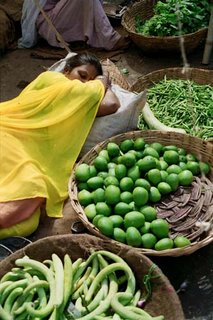
More Photos at the
Apple GalleryHere a picture i took of a baby elephant i came across on regularly.
The Indian Elephant goes back to the mythologies. As the Gods "Deva" and the demons "Asura"churned the oceans during ‘sagar manthan’ ( sagar = sea ; manthan = churning ) for the elixir of life - ‘amrit’ ( nectar ) that would make them immortal , there surfaced the ‘navratnas’ ( nine jewels ). One of these jewels was the elephant. The elephant is, therefore, considered absolutely precious to be preserved and protected like the way jewels are.
There are other mythological stories. For example, in one of her dreams, Buddha’s mother dreamt of a white elephant. And then the prophet of peace Gautam Buddha was born. Obviously, therefore, a white elephant in India’s cultural context can never connotate redundancy, as it would in the West.
And then comes the greatest of all ‘vahanas’ (carriages for Gods) - the "Airavat" ( elephant ). The Airavat was the chosen carriage for the God of all Gods "Indra". There were other Gods as well riding on elephants as well, but Indra’s airavat was special. It was regal in size and had ten tusks, not just the usual two.
The Asian elephant is one of three species , the others being the Savanna elephant and the Forest elephant.
The Indian elephant is larger, has longer front legs and a thinner body than the Asian elephant found in Thailand.
The elephant plays an important part in the culture of the subcontinent and beyond featuring prominently in Jataka tales and the Panchatantra. It is also quite venerated and the "blessings" of a temple elephant is sought by Hindus as Lord Ganesha's head is made up of an elephant. It has been used in majestic processions in Kerala where the pachyderms are adorned with festive outfits. They were used by almost all armies in India as war elephants, terrifying opponents unused to the massive beast..
In Kerala, south India for festivals and ceremonial rounds inside the Hindu temples, elephants are caparisoned with the head gears ('Netti pattam' in Malayalam language) which are gold plated.
Seventeen elephants are engaged for the daily ceremonial rounds to the accomplishment of Panchari Melam in the Koodalmanikyam Temple in which the head gears of seven elephants are made of pure gold and rest of pure silver which is an uniqueness of this temple.








 Came across these rice field workers on morning while travelling from Mahabalipuram(Mammalapuram) to Kanchipuram in Tamil Nadu.
Came across these rice field workers on morning while travelling from Mahabalipuram(Mammalapuram) to Kanchipuram in Tamil Nadu.




